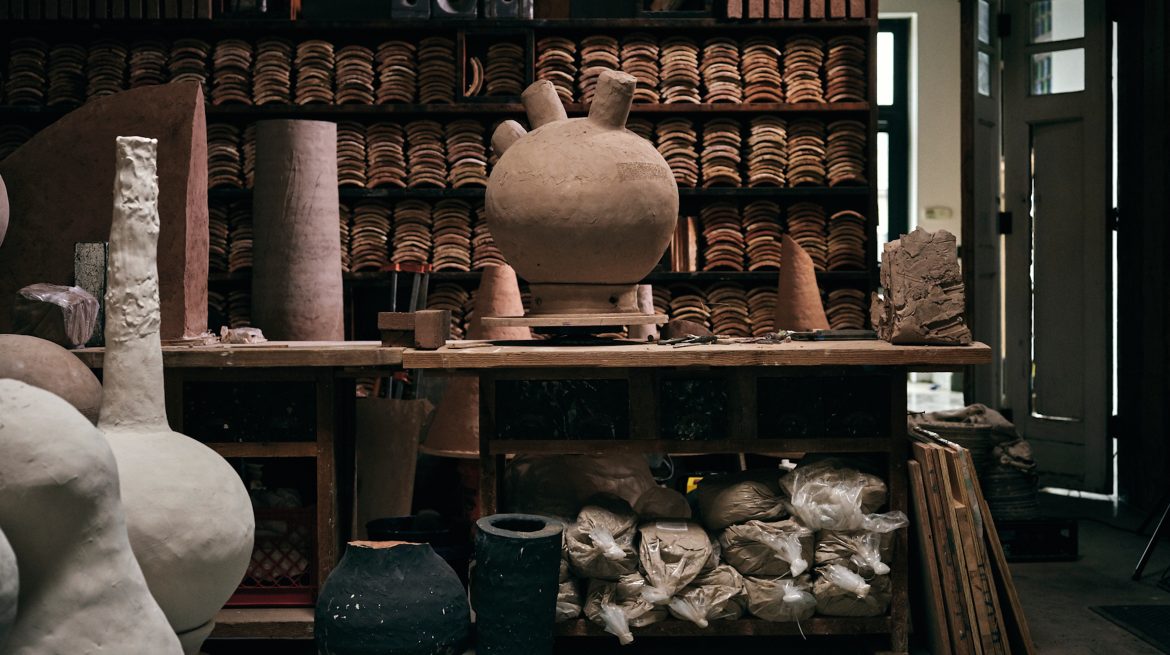PREVIEW: Theaster Gates-The Question of Clay
 Theaster Gates’ practice includes sculpture, installation, performance and urban interventions that aim to bridge the gap between art and life. Gates works as an artist, curator, urbanist and facilitator and his projects attempt to instigate the creation of cultural communities by acting as catalysts for social engagement that leads to political and spatial change.
Theaster Gates’ practice includes sculpture, installation, performance and urban interventions that aim to bridge the gap between art and life. Gates works as an artist, curator, urbanist and facilitator and his projects attempt to instigate the creation of cultural communities by acting as catalysts for social engagement that leads to political and spatial change.
By Efi Michalarou
Photo: Whitechapel Gallery Archive
Clay has been central to Theaster Gates’s practice since earning an MA in urban planning and ceramics at Iowa State University in 1996 and subsequently studying pottery in Tokoname, Japan. “The Question of Clay”, is a multi-institution project by Theaster Gates which will take place in 2021-22 across Whitechapel Gallery, Serpentine and the V&A. The project seeks to investigate the making, labour and production of clay, as well its collecting history, through exhibitions, performance and live interventions, with the aim of generating new knowledge, meaning and connections about the material. Gates’s transformation of clay – from geological substance into utilitarian and artistic material – stands as a powerful metaphor for his socially-engaged work and wider artistic practice. Featuring ceramic objects, sculptures, installations, film and studio materials from the past two decades, this in-depth exploration from the critically acclaimed artist considers the material and spiritual legacies of clay. He has been working with its ceramic collections to examine the relationship between Eastern and Western aesthetic practices and political histories within craft. The exhibition at Whitechapel Gallery will begin with a survey of the artist’s clay works – from examples of his early ceramic production to ‘Afro-Mingei’ sculptures and large vessels – alongside examples by those who have shaped Gates’s approach to clay. They include David Drake, an enslaved African American potter who worked on a plantation in South Carolina. Drake wrote poems and signed his stoneware pots when literacy among enslaved people was outlawed. The exhibition also includes potters who exchanged traditions from different cultural contexts, such as Bernard Leach and Shoji Hamada, who established the influential Leach Pottery in St Ives, Cornwall in 1920, and Ruth Duckworth, who fled the Nazi regime, studied in the UK and made her mark with monumental stoneware murals in Chicago. Working in partnership with the V&A and drawing from other public and private collections, Gates has selected a number of historic objects for his Whitechapel Gallery exhibition that speak to the significance of ceramics in global trade, colonial expansion, slavery and abolitionism in the UK. The exhibition further includes a new film by Gates and his most recent body of work: large stoneware vessels installed on custom-made plinths of hand-milled wood and stone. Their forms derive from a range of sources, including African sculpture, the human body and industrial and utilitarian objects. Alongside his own work, Gates has made a selection of historic ceramics from private and public collections, including the Victoria and Albert Museum, where he has been Emeritus Fellow at the V&A Research Institute. The exhibition also includes a new film by Gates, which takes the form of a sermon on clay, and his most recent body of work: large stoneware vessels installed on custom-made plinths of hand-milled wood and stone.
Info: Curator: Lydia Yee, Assistant Curator: Cameron Foote, Whitechapel Gallery, 77-82 Whitechapel High St, London, England, Duration: 29/9/2021-9/1/2022, Days & Hours: Tue-Sun 11:00-18:00, www.whitechapelgallery.org
